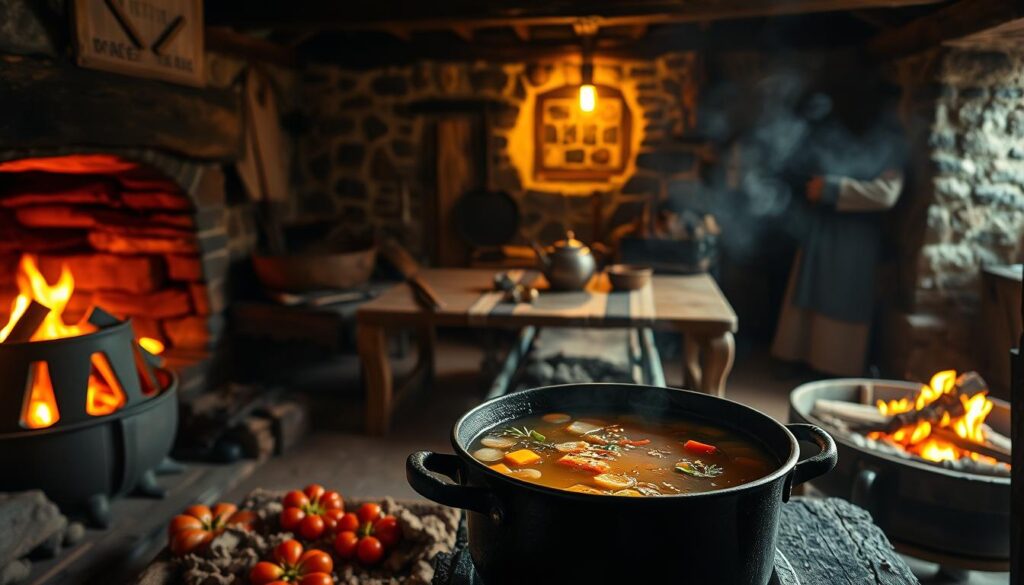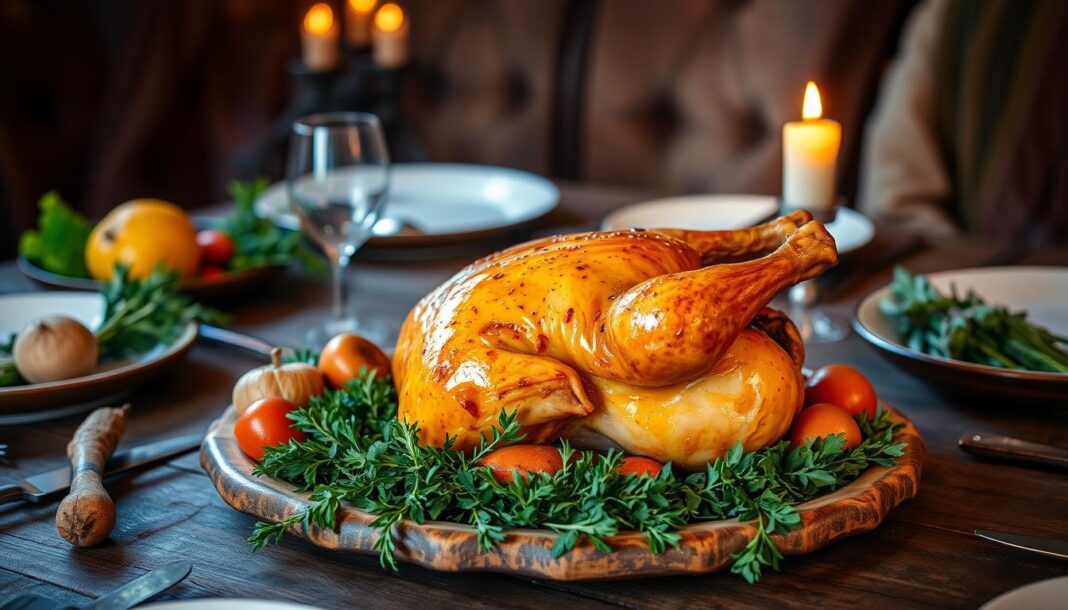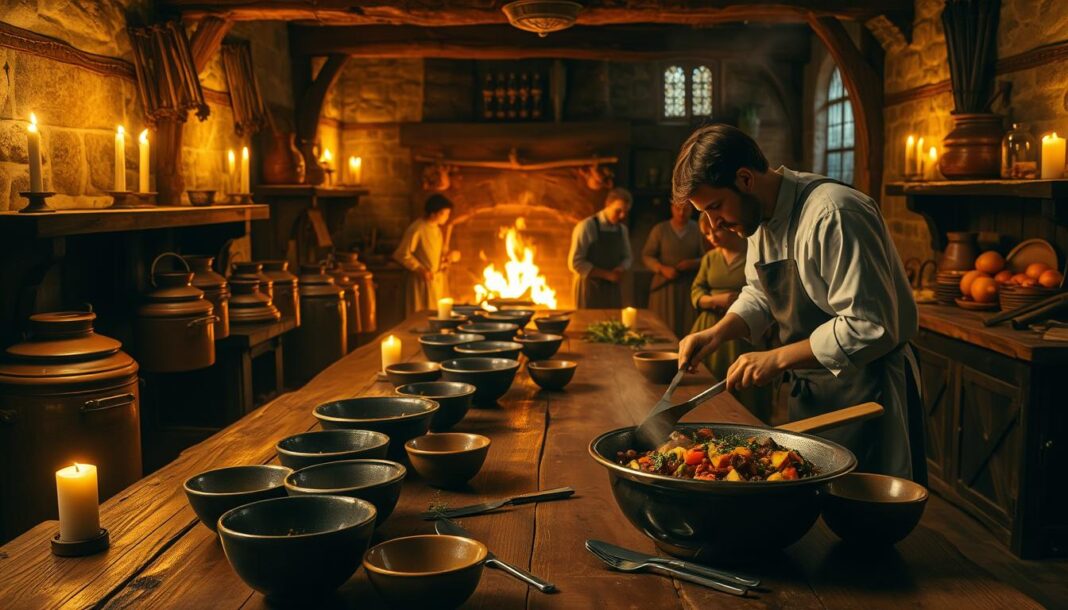We explore an authentic 13th-century roasted chicken dish, examining its historical preparation methods and comparing them to modern cooking techniques. The Teutonic chicken broth recipe, sourced from the Liber de Coquina, showcases the simplicity and flavor balance of medieval cooking.
Our team has meticulously researched and tested this traditional recipe, providing you with both historical accuracy and practical cooking advice. By understanding the historical context of this dish, we gain valuable insights into medieval culinary traditions and the evolution of cooking techniques over time.
Key Takeaways
- Discover the authentic flavors of a 13th-century roasted chicken dish.
- Learn about the historical preparation methods and ingredients used.
- Compare medieval cooking techniques to modern methods.
- Gain practical cooking advice from our tested recipe.
- Understand the evolution of culinary traditions over time.
The Origins of Teutonic Chicken Broth
Our exploration of the Teutonic chicken broth recipe reveals the complex dynamics of culinary exchange in medieval Europe. The recipe, referred to as “Teutonic” by the author, may not be an authentic Germanic recipe but rather an interpretation of a dish he encountered. This broth represents a fascinating intersection of culinary traditions.

The Liber de Coquina manuscript, where this recipe appears, is a valuable resource for understanding medieval cooking practices and cross-cultural exchange. It showcases how recipes traveled and were adapted across different regions.
13th Century Italian Interpretations
In 13th-century Italy, foreign recipes were often adapted to local tastes and ingredients. The Teutonic chicken broth is a prime example, reflecting the dynamic nature of medieval cuisine. It features few, well-selected ingredients, creating a simpler yet delicious dish.
Historical Significance of the Recipe
The historical significance of Teutonic chicken broth extends beyond its flavor. It demonstrates a sophisticated understanding of flavor combinations and cooking techniques. Medieval cooks balanced flavors and textures, challenging our preconceptions about medieval food.
| Aspect | Medieval Cooking | Modern Cooking |
|---|---|---|
| Ingredient Selection | Few, well-selected ingredients | Varied and complex ingredient lists |
| Culinary Techniques | Simple, traditional methods | Diverse, modern techniques |
| Flavor Profiles | Balanced, nuanced flavors | Complex, layered flavors |
For more details on the Teutonic chicken broth recipe, you can visit our related article on medieval Teutonic chicken.
Authentic Medieval Times Roasted Chicken Recipe
Delving into the heart of medieval cuisine, we uncover the secrets of the authentic roasted chicken recipe. This dish, rooted in history, offers a glimpse into the cooking practices of the past.
Traditional Ingredients and Substitutions
The original recipe calls for capons or fat hens, which were simmered for a long time with salt. The use of fatty birds was crucial as the recipe doesn’t include additional cooking fats. For those looking to recreate this dish today, substitutions can be made to maintain the spirit of the original while ensuring accessibility.
We found that while some traditional ingredients might be difficult to source today, appropriate substitutions can be made. For instance, using a plump and fatty chicken can replicate the richness of the original capons or fat hens.
The Importance of Aromatic Herbs
Aromatic herbs play a crucial role in this medieval recipe. Medieval cooks used a variety of herbs including parsley, mint, marjoram, and rosemary to create complex flavor profiles. We recommend using at least three herbs to give enough complexity to the dish, much like the cooks of the time.
For more insights into medieval culinary practices and other historical recipes, you can explore our content on fantasy meals, which offers a broader look into the imaginative and resourceful world of medieval cuisine.
Step-by-Step Medieval Cooking Method
Our journey into medieval cooking techniques led us to a step-by-step guide on preparing roasted chicken, just like they did centuries ago. This traditional recipe requires patience and attention to detail to achieve the rich flavors characteristic of medieval cuisine.
Preparing and Simmering the Hen
The process begins with cutting a whole chicken into pieces, a task that would have been done with simple tools in medieval kitchens. The pieces are then simmered with salt and water, with additional water added as needed to prevent drying out. This cooking process takes at least a couple of minutes, typically 120 minutes or more, resulting in a concentrated broth.
Adding Saffron and Herbs
Once the hen is cooked through, aromatic herbs are minced and saffron is steeped in water or ground in a mortar. These ingredients are then added to the pot, and the mixture is boiled for a couple of minutes. The dish is served hot, accompanied by its rich broth.
| Cooking Stage | Action | Time |
|---|---|---|
| Preparation | Cut chicken into pieces | – |
| Simmering | Simmer with salt and water | At least 120 minutes |
| Finalizing | Add saffron and herbs, boil | A couple of minutes |
Our Testing Results and Modern Adaptations
We discovered that the Medieval Times Roasted Chicken Recipe, with its straightforward ingredients and method, yields a remarkably sophisticated dish. Our testing revealed that despite its simplicity, the recipe delivers complex flavors that appeal to modern palates. Cooking the chicken took around 150 minutes, but using a slow cooker can be a convenient alternative. We suggest slight adjustments to salt levels and herb proportions for contemporary tastes. This ancient recipe demonstrates that quality cooking transcends time, making it a timeless addition to any kitchen.


